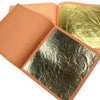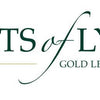Gold Leaf Across the World - Türkiye
- by Sam Wozniak
Gold Leaf in Turkey: A Gilded Heritage of Art, Faith, and Restoration
Gold leaf — those delicate, luminous sheets of hammered gold — has fascinated humanity for millennia. In Turkey (Türkiye), its story unfolds across empires, faiths, and centuries of artistry. From Byzantine mosaics to Ottoman mosques and contemporary restoration efforts, gold leaf has been more than a symbol of beauty; it’s a language of reverence, power, and permanence.
Whether in pure 24 carat gold leaf for sacred art or 23.5 carat gold leaf for architectural detailing, Turkey’s gilding tradition connects the monumental achievements of the past with the refined craftsmanship of the present.
A Golden Beginning: Early Gilding in Anatolia
The roots of gilding in Turkey reach deep into antiquity. Anatolia, the ancient heartland of modern Turkey, was home to some of the earliest civilizations that worked with gold — including the Hittites, Phrygians, and Lydians. The Lydians, in particular, are credited with producing the world’s first gold coins in the 7th century BCE, a testament to the region’s longstanding relationship with gold.
The use of gold leaf as an artistic medium likely began with the Greeks and Romans who settled across Anatolia. Roman-era temples, sculptures, and mosaics often employed gold leaf gilding to highlight divine figures and architectural ornamentation. By the Byzantine era, this technique evolved into an art form of immense spiritual significance.
The Byzantine Era: Divine Light in Gold
During the Byzantine Empire, which ruled much of what is now Turkey for over a thousand years, gold leaf became a cornerstone of religious and imperial art. Churches such as the Hagia Sophia in Istanbul showcased vast mosaics where gold leaf was used to create radiant backgrounds symbolizing heaven and divine light.
Byzantine artisans often used 24 carat gold leaf, chosen for its unmatched purity and brilliance. They sandwiched thin layers of gold between glass tesserae, embedding them into mosaic compositions of Christ, the Virgin Mary, and saints. The result was a spiritual visual effect: as sunlight filtered through domes and windows, the mosaics shimmered, creating an ethereal, otherworldly atmosphere.
This period firmly established gilding as not only an artistic choice but also a theological statement — gold represented eternity, purity, and divine presence. The technique spread from monumental cathedrals in Constantinople to monasteries and chapels across Anatolia.
The Ottoman Empire: Monumental Brilliance and Royal Craftsmanship
When the Ottomans rose to power in the 14th century, they inherited and transformed the gilding traditions of their Byzantine predecessors. Under Ottoman rule, gold leaf became synonymous with royal grandeur and Islamic artistry.
The use of 23.5 carat goldleaf was common in architectural ornamentation due to its slightly enhanced durability compared to pure 24 carat gold, especially in humid or high-contact environments. This goldleaf was applied to wood, plaster, and metal surfaces, adorning everything from mosque domes and calligraphy panels to palace interiors.
Gilding in Ottoman Mosques and Palaces
The Topkapi Palace in Istanbul stands as a prime example of the Ottoman fascination with gold. Its ornate ceilings, intricate woodwork, and manuscript decorations were enriched with hand-applied gold leaf gilding, often executed by highly trained artisans known as nakkaş.
Mosques such as the Süleymaniye Mosque and Blue Mosque (Sultan Ahmed Mosque) also feature gilded inscriptions and decorative motifs. The reflective quality of gold enhanced the natural light within these sacred spaces, symbolizing the spiritual illumination of faith.
In addition to monumental architecture, Ottoman miniatures and illuminated manuscripts featured extensive use of gold leaf. The artisans of the royal nakkaşhane (imperial workshop) applied 24 carat gold leaf with meticulous precision to accentuate the halos of prophets, the borders of verses, and the intricate geometric designs that defined Islamic art.
Techniques and Symbolism in Turkish Gilding
Traditional Turkish gilding techniques evolved through a blend of Byzantine, Persian, and Arab influences. The two most common methods were water gilding and oil gilding. Water gilding, used primarily for interior woodwork and manuscripts, involved applying gold leaf over a clay-based surface known as bole. Oil gilding, more resistant to wear, was used on architectural and metallic elements.
The symbolism of goldleaf in Turkish art transcended its material value. Gold represented divine light, knowledge, and power — a bridge between the earthly and the spiritual. Its reflective surface was thought to attract light and ward off darkness, aligning perfectly with Islamic and Byzantine philosophies of illumination.
Decline and Rediscovery: The Modern Era of Gold Leaf in Turkey
By the late 19th and early 20th centuries, industrialization and modernization began to replace traditional craftsmanship with mass production. The intricate art of gilding declined as new materials and paints became more accessible. However, interest in traditional goldleaf techniques never fully disappeared.
In the mid-20th century, as Turkey embarked on heritage preservation and restoration projects, gold leaf made a strong comeback. The need to restore Ottoman mosques, Byzantine churches, and imperial palaces sparked renewed demand for authentic gilding artisans.
Gold Leaf in Restoration and Conservation
Today, gold leaf restoration plays a crucial role in Türkiye's cultural heritage preservation. The country’s vast collection of historical monuments requires skilled gilders to maintain the authenticity of original works.
At the Hagia Sophia, experts have carefully restored gold mosaics using 24 carat goldleaf to match the Byzantine originals. Similarly, restorations at Topkapi Palace, the Dolmabahçe Palace, and various mosques in Istanbul and Edirne have relied on 23.5 carat gold leaf to ensure both historical accuracy and structural longevity.
Restoration specialists must balance traditional techniques with modern conservation science. Factors such as humidity, temperature, and light exposure determine whether 23.5 or 24 carat gold leaf is applied, as the slight alloy difference in 23.5 carat gold improves resistance to environmental wear without compromising lustre.
These monumental restoration efforts are not only about preserving aesthetics — they are about safeguarding the narrative of Turkish identity, spirituality, and craftsmanship.
Contemporary Uses: Gold Leaf in Modern Turkish Art and Design
In recent decades, Turkish artists, designers, and architects have reinterpreted goldleaf in fresh, contemporary ways. Gold leaf now appears in modern paintings, abstract sculpture, calligraphy, and interior design, often used to connect the grandeur of the past with the innovation of the present.
Contemporary Turkish calligraphers frequently incorporate 24 carat gold leaf into their compositions, maintaining the traditional Islamic reverence for gold as a symbol of divine illumination. In interior design, gold leaf adds a sense of luxury and heritage to modern spaces — from boutique hotels in Istanbul to restored Ottoman mansions along the Bosphorus.
Some modern architects and artisans use 23.5 carat gold leaf for dome decoration and architectural accents, balancing endurance with elegance. Others have taken gilding into unexpected directions, using goldleaf on ceramics, textiles, and even culinary presentations for high-end events — demonstrating how the material continues to evolve in meaning and application.
Türkiye's Golden Future: The Enduring Allure of Gilding
Gold leaf in Turkey represents more than artistic beauty — it embodies continuity. From the shimmering mosaics of the Byzantine Empire to the monumental mosques of the Ottomans and the precision of today’s restoration workshops, the art of gilding bridges centuries of human creativity and devotion.
Whether applied as 24 carat gold leaf in religious icons or 23.5 carat in architectural gilding and restoration, it continues to reflect not just light, but history itself. Turkey’s ongoing commitment to preserving and celebrating this golden tradition ensures that the brilliance of its past will continue to illuminate its cultural future.
Conclusion
The story of gold leaf in Turkey is one of resilience, artistry, and reverence. It is a narrative that spans empires, faiths, and disciplines — a story told in the gleam of a dome, the shimmer of a manuscript, or the restored glow of a palace wall.
As restoration specialists, artists, and historians keep this legacy alive, gold leaf remains a living symbol of Turkey’s monumental past and its shining creative spirit.






